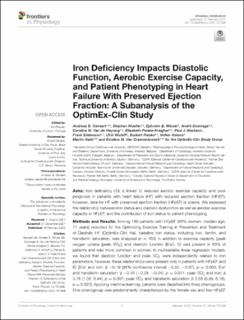| dc.contributor.author | Gevaert, Andreas B. | |
| dc.contributor.author | Mueller, Stephan | |
| dc.contributor.author | Winzer, Ephraim B. | |
| dc.contributor.author | Duvinage, André | |
| dc.contributor.author | Van de Heyning, Caroline M. | |
| dc.contributor.author | Pieske-Kraigher, Elisabeth | |
| dc.contributor.author | Beckers, Paul J. | |
| dc.contributor.author | Edelmann, Frank | |
| dc.contributor.author | Wisløff, Ulrik | |
| dc.contributor.author | Pieske, Burkert | |
| dc.contributor.author | Adams, Volker | |
| dc.contributor.author | Halle, Martin | |
| dc.contributor.author | Van Craenenbroeck, Emeline M. | |
| dc.date.accessioned | 2023-01-18T13:00:40Z | |
| dc.date.available | 2023-01-18T13:00:40Z | |
| dc.date.created | 2022-05-02T14:00:20Z | |
| dc.date.issued | 2022 | |
| dc.identifier.citation | Frontiers in Physiology. 2022, 12 . | en_US |
| dc.identifier.issn | 1664-042X | |
| dc.identifier.uri | https://hdl.handle.net/11250/3044331 | |
| dc.description.abstract | Aims: Iron deficiency (ID) is linked to reduced aerobic exercise capacity and poor prognosis in patients with heart failure (HF) with reduced ejection fraction (HFrEF); however, data for HF with preserved ejection fraction (HFpEF) is scarce. We assessed the relationship between iron status and diastolic dysfunction as well as aerobic exercise capacity in HFpEF, and the contribution of iron status to patient phenotyping.
Methods and Results: Among 180 patients with HFpEF (66% women; median age, 71 years) recruited for the Optimizing Exercise Training in Prevention and Treatment of Diastolic HF (OptimEx-Clin) trial, baseline iron status, including iron, ferritin, and transferrin saturation, was analyzed (n = 169) in addition to exercise capacity (peak oxygen uptake [peak V̇O2]) and diastolic function (E/e′). ID was present in 60% of patients and was more common in women. In multivariable linear regression models, we found that diastolic function and peak V̇O2 were independently related to iron parameters; however, these relationships were present only in patients with HFpEF and ID [E/e′ and iron: β−0.19 (95% confidence interval −0.32, −0.07), p = 0.003; E/e′ and transferrin saturation: β−0.16 (−0.28, −0.04), p = 0.011; peak V̇O2 and iron: β 3.76 (1.08, 6.44), p = 0.007; peak V̇O2 and transferrin saturation: β 3.58 (0.99, 6.16), p = 0.007]. Applying machine learning, patients were classified into three phenogroups. One phenogroup was predominantly characterized by the female sex and few HFpEF risk factors but a high prevalence of ID (86%, p < 0.001 vs. other phenogroups). When excluding ID from the phenotyping analysis, results were negatively influenced.
Conclusion: Iron parameters are independently associated with impaired diastolic function and low aerobic capacity in patients with HFpEF and ID. Patient phenotyping in HFpEF is influenced by including ID. | en_US |
| dc.language.iso | eng | en_US |
| dc.publisher | Frontiers Media | en_US |
| dc.rights | Navngivelse 4.0 Internasjonal | * |
| dc.rights.uri | http://creativecommons.org/licenses/by/4.0/deed.no | * |
| dc.title | Iron Deficiency Impacts Diastolic Function, Aerobic Exercise Capacity, and Patient Phenotyping in Heart Failure With Preserved Ejection Fraction: A Subanalysis of the OptimEx-Clin Study | en_US |
| dc.title.alternative | Iron Deficiency Impacts Diastolic Function, Aerobic Exercise Capacity, and Patient Phenotyping in Heart Failure With Preserved Ejection Fraction: A Subanalysis of the OptimEx-Clin Study | en_US |
| dc.type | Peer reviewed | en_US |
| dc.type | Journal article | en_US |
| dc.description.version | publishedVersion | en_US |
| dc.source.pagenumber | 0 | en_US |
| dc.source.volume | 12 | en_US |
| dc.source.journal | Frontiers in Physiology | en_US |
| dc.identifier.doi | 10.3389/fphys.2021.757268 | |
| dc.identifier.cristin | 2020712 | |
| cristin.ispublished | true | |
| cristin.fulltext | original | |
| cristin.qualitycode | 1 | |

